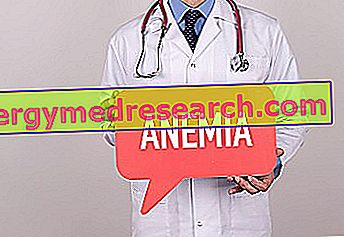Generality
Ectoparasites are parasites that live on the outer surface of the host, or in easily accessible cavities, such as the nose, ears and mouth.

The ectoparasites of medical interest are mostly arthropods (Phylum Arthropoda), the most famous of which are undoubtedly fleas, ticks, lice and mites. In general, arthropods are ectoparasites at the adult stage, but in some cases they can also be larval.
Ectoparasitic infestation can occur in both humans and animals and is called ectoparasitosis .
Types of Ectoparasites
The currently known ectoparasites are really many and belong to the most varied species.
However, ectoparasites can be divided into two large groups:
- Permanent ectoparasites : they are parasites that live permanently on the host's body surface. This is because these organisms depend on the host not only for nutrition, but also for other factors essential to their survival, such as, for example, body temperature.
- Temporary ectoparasites : they are parasites that can lead most of their life in the external environment and that attack humans and animals only when they have to feed on their blood ( hematophagous ectoparasites ).
Ectoparasites of Health Interest
The ectoparasites of health interest are considered as such substantially because they can give rise to real pathologies and / or can act as vectors for the transmission of viruses, bacteria and other parasites which, in turn, can cause serious diseases.
As mentioned, the main ectoparasites of medical interest are arthropods. Therefore, the main characteristics of ectoparasitic arthropods whose infestations have a high clinical relevance for humans will be described below.
Mites
Mites are permanent ectoparasites belonging to the class of arachnids. The species belonging to this group are really many, among these we remember: Sarcoptes scabiei, Demodex folliculorum and Demodex brevis .
Most of the species belonging to the genus Demodex , in humans, are mostly localized at face and nose level, where, however, they do not cause appreciable alterations or damages. However, it is important to point out that some ectoparasites belonging to this genus are considered to be responsible for the transmission of Hansen 's bacillus, or the etiological agent that causes leprosy.
Sarcoptes scabiei, on the other hand, is the ectoparasite responsible for the onset of scabies, a particular skin infection that affects both men and animals.
Curiosity
There are numerous varieties of S. scabiei, each of which is usually host-specific . This means that each mite is able to attack, infest and trigger scabies in specific hosts: there will be a mite capable of causing scabies in men, one capable of causing it in dogs and so on for other animals. The scabies mite that affects humans is S. scabiei var. hominis .
However, the parasites responsible for animal scabies can still attack humans, causing similar symptoms - but not the same - to those caused by man's scabies mite.
There are also other mites belonging to different genera that normally infest animals and plants, but which can occasionally also attack humans causing scales-crusting lesions.
Finally, we cannot certainly forget the dust mites, which are important above all for their allergenic power .
Pathogenicity and Clinical Manifestations
The ectoparasites belonging to the genus Demodex cause acne-type skin lesions generally not very evident and itchy. Furthermore, the presence of mites belonging to this genus could favor the appearance of pimples and / or folliculitis.
The clinical relevance of the S. scabiei infestation, on the other hand, is decidedly greater. The female of S. scabiei, in fact, digs real burrows on the skin of the host in order to lay eggs. This behavior causes to the host vesicles and intense itching, often accompanied by scratching lesions.
In immunosuppressed or debilitated patients, infestation by S. scabiei can lead to the appearance of the so-called "Norwegian scab" which is characterized by the onset of squamous-crusted lesions.
Ticks
Ticks are temporary ectoparasites that live most of their lives in the external environment and attack humans (or animals) only to feed on their blood. In this regard, it should be emphasized that ticks are hematophagous not only in the adult state, but also in the larval stage.
There are really many species of ticks that can attack humans in Italy. These include: Ixodes ricinus (the most widespread species), I. gibbosus, I. hexagonus, Haemaphysalis punctata and Dermacentor marginatus .
Numerous species of ticks are considered dangerous because they are able to transmit to the host pathogens responsible for serious pathologies, such as Lyme disease, tick-borne meningoencephalitis, ehrlichiosis and rickettsiosis .
Pathogenicity and Clinical Manifestations
The tick bite is very particular and different from that of other ectoparasites. The tick, in fact, when it attacks the guest for dining, inoculates its saliva which is able to digest the tissues with which it comes into contact, causing the rupture of the blood and lymphatic capillaries. All this therefore leads to the formation of traumatic injuries . Typically, the tick bite lesion manifests as an erythematous patch in the center of which is a bluish-colored patch.
Did you know that ...
In case of tick infestation, these should be removed with extreme caution from the body surface of the affected man (or animal). In fact, to be able to feed, the tick has a beak that is inserted into the skin. Tearing the ectoparasite from the skin with excessive energy there is the risk that the rostrum breaks off, favoring the release of the intestinal content of the arthropod. It is precisely in the intestinal content of the ticks that can harbor the pathogens transmitted by these ectoparasites.
Therefore, removal of the tick should be done by first covering it with oil, in order to hinder its breathing. After that, the arthropod should be removed very slowly and progressively, performing a rotary movement, as if to "unscrew it". In this way, the risk of breaking the rostrum should be greatly reduced.
The mint should then be analyzed in order to assess the presence of possible pathogens, in order to determine the need or not to carry out prophylactic drug therapies.
However, if you are attacked by a tick, it is always good to ask your doctor for advice on what to do (or the veterinarian in the case of animals).
Fleas
Fleas are ectoparasites, generally temporary, belonging to the class of insects (order of the afanitteri). Fleas can infest both mammals (including humans) and birds.
Among the species that most commonly attack humans, we mention: Pulex irritans, Ctenocephalides felis, C. canis and Xenopsylla cheopis .
Pathogenicity and Clinical Manifestations
The lesions caused by the fleas are painful but of modest magnitude and manifest themselves with erythemato-pomfoid type reactions. In children, however, blisters may also appear.
What is most worrying about flea bites is the potential transmission of pathogens. In fact, fleas can be carriers of bacteria, viruses and helminths and are responsible for the transmission of serious diseases, such as, for example, the plague, murine typhus, endemic typhus and infectious myxomatosis.
Lice
Lice are permanent and obligate ectoparasites belonging to the order of anopluri, forming part of the class of insects. The lice of sanitary interest for humans are Pediculus humanus capitis ( head lice ), P. humanus humanus ( clothes lice ) and Phthirus pubis ( pubic lice ).
P. humanus capitis is the one that most commonly afflicts childhood communities and is transmitted by direct contact from individual to individual.
Pathogenicity and Clinical Manifestations
Injuries caused by lice are very annoying, as they cause skin itching and irritation.
Furthermore, P. humanus humanus can also be the vector of various pathogens capable of causing diseases such as recurrent epidemic fever, exanthematous typhus and trench fever.
Bedbugs
Bedbugs are temporary ectoparasites belonging to the class of insects and the order of heterotters.
The best known ectoparasites of this type are undoubtedly the so-called bed bugs ( Cimex lectularius ), so called because, generally, they infest the mattresses and bite the man through the linen.
Pathogenicity and Clinical Manifestations
The bite of bed bugs is usually painless, but it causes itching and erythematous-edematous lesions. Furthermore, in some cases, more severe symptoms may also occur, such as tachycardia and general malaise.
Diptera
Diptera are insects with wings, therefore, able to fly and move easily. Diptera can be subdivided into hematophagous and not hematophagous.
Haematophagous dipterans are considered true ectoparasites ; among those of human interest, we recall the common mosquito, the tiger mosquito and numerous other mosquito species, the sand flies, horseflies and the tsetse fly.
Non-hematophagous flies, on the other hand, are considered more than anything else as " mechanical pathogen diffusers ". This is because non-hematophagous dipterans feed on different types of organic material that could be contaminated by various pathogens. Through the legs, feces and regurgitation, these insects are therefore able to transport and spread bacteria, viruses and parasites.
Pathogenicity and Clinical Manifestations
The bite of the flies does not worry so much about the type of lesions that derive from it - which, however, can be very annoying, painful or itchy - but it is especially worrying for the potential transmission of pathogens. These hematophagous ectoparasites - as well as non-bloodsucking dipterans - can, in fact, transmit bacteria, viruses and other parasites capable of triggering very serious diseases that can affect both men and animals. These include: leishmaniasis, sleeping sickness, Zika virus fever, anthrax, filaria, dengue, chikungunya and yellow fever.
Treatments and Treatments
Cures and treatments against ectoparasitic infestations can vary greatly depending on various factors, such as the type of parasite that has infested the host, the stage in which it is found, the health of the host and so on.
In some cases - for example, in the presence of mites and lice - the use of pharmacological treatment with topical pesticides (such as, for example, permethrin) may prove useful.
On other occasions, instead, it is necessary to carry out a disinfestation of the environment in which one lives, as in the case of bedbugs.
In the case of ticks, on the other hand, in addition to the removal of these ectoparasites from the skin of the host, it is possible to intervene with prophylactic therapies against the pathogens that these ectoparasites are able to transmit.
Fleas and Diptera, on the other hand, are fought more than anything else with the use of suitable repellents, in order to prevent their bites.
However, in case of suspected infestation or ectoparasitic puncture, it is always good to contact your doctor who will be able to provide all the necessary information and - evaluating each case - will prescribe the most suitable drug therapy.



